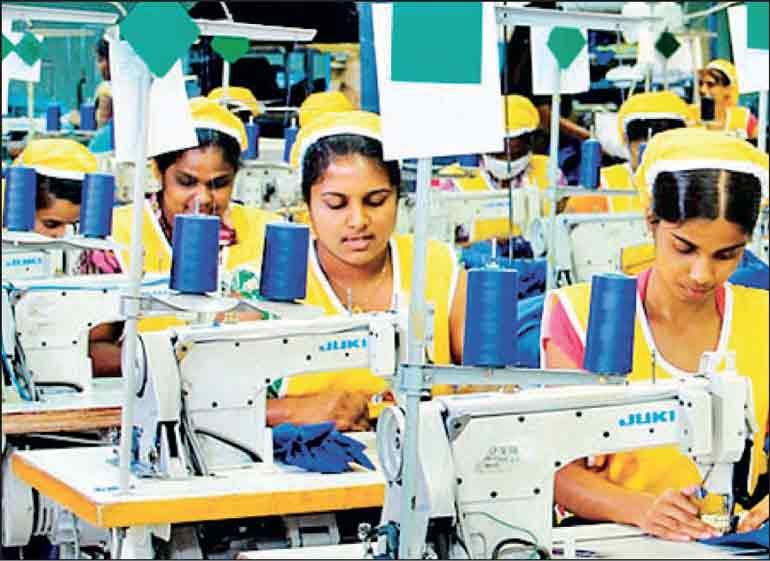Monday Apr 14, 2025
Monday Apr 14, 2025
Thursday, 10 April 2025 00:20 - - {{hitsCtrl.values.hits}}

While the tariffs are intended to address trade imbalances, their impact on countries like Sri Lanka could be severe, particularly for key sectors such as textiles and rubber products
 In a controversial move on 2 April 2025, President Donald Trump announced the imposition of reciprocal tariffs on imports from approximately 90 countries, sending shockwaves through the global trade landscape. These tariffs, which exceed a 10% across-the-board tax on all imports to the United States, are designed to address the US’s trade deficit with several major trading partners, including China and the European Union. Trump framed the announcement as “Liberation Day,” asserting that these tariffs were necessary to rectify the imbalance in trade.
In a controversial move on 2 April 2025, President Donald Trump announced the imposition of reciprocal tariffs on imports from approximately 90 countries, sending shockwaves through the global trade landscape. These tariffs, which exceed a 10% across-the-board tax on all imports to the United States, are designed to address the US’s trade deficit with several major trading partners, including China and the European Union. Trump framed the announcement as “Liberation Day,” asserting that these tariffs were necessary to rectify the imbalance in trade.
The principle behind these tariffs, referred to as “reciprocal,” involves imposing matching tariffs to those other countries place on US imports. In President Trump’s words, “They do it to us, and we do it to them.” Under this policy, Asian nations, in particular, are expected to bear the heaviest burden. Cambodia, for example, faces a tariff rate of 49%, Vietnam is subject to a 46% tax, and Sri Lanka faces a 44% levy. Additionally, China’s imports will be taxed at an overall rate exceeding 60%, factoring in both the reciprocal tariffs and previously announced duties. Despite the considerable disruption these measures could cause, some analysts suggest that these tariffs may be part of a broader negotiation strategy aimed at compelling foreign governments to agree to more favourable trade deals with the United States.
Some economists mentioned that “The president loves creating a situation where other countries or individuals have to come and bargain with him. By setting out different tariff rates on a country-by-country basis, it creates a situation where every country then has to supplicate and beg and negotiate with the White House on an individual basis.”
Potential impact on Sri Lanka
Sri Lanka’s latest trade and export policy sets an ambitious target of achieving annual export revenue of $ 18.2 billion by 2025. The strategy involves increasing merchandise exports from $ 12.7 billion to $ 14 billion, and service exports from $ 3.5 billion to $ 4.2 billion. Key sectors driving this growth include apparel ($ 5.2 billion), tea ($ 1.4 billion), rubber ($ 1 billion), and gems and jewellery ($ 650 million). The ICT sector is expected to reach $ 1.7 billion by 2025, with an eye on $ 5 billion by 2030, supported by tax reductions. Emerging industries such as boat manufacturing ($ 200 million) and traditional exports like seafood ($ 300 million) and coconuts ($ 800 million) will contribute to this goal. However, recent reciprocal tax issues could pose a challenge to achieving this target, as the policy’s potential benefits might be drastically undermined by such reciprocal tax implications.
The newly imposed tariffs are particularly concerning for Sri Lanka, which is a major exporter to the United States. As of 2024, total trade between the US and Sri Lanka amounted to approximately $ 3.4 billion, with Sri Lanka exporting around $ 3.0 billion in goods to the US. The sectors most at risk include textiles, rubber products, and other manufacturing industries that have grown steadily over the past two decades. These industries, which have benefited from Sri Lanka’s reputation for high-quality, low-cost, and efficient manufacturing, now face significant challenges. The 44% reciprocal tariff on Sri Lankan goods threatens to severely strain profit margins, reduce order volumes, reduced foreign exchange earnings, impact on banking industry, building up reserves, deterring investments, slowing GDP and potentially lead to job losses.
It is reported that the apparel sector directly employs approximately 362,500 individuals and indirectly supports around 1.0 million jobs, highlighting the significance of the issue. If not addressed, this could lead to social unrest and have a cascading effect on other sectors. This would also making it difficult for Sri Lanka to meet its ambitious export target of $ 18 billion. With a 44% tariff, many US retailers may now shift to sourcing from countries like India or Mexico, which face lower duties. Even a 10% difference in costs can sway buyers in a highly price-sensitive industry.
Additionally, with the relaxation of vehicle import restrictions and pent-up demand for other products and services, pressure on foreign exchange rates is expected to increase, potentially reaching levels between Rs. 305-310 by the third quarter. The Central Bank of Sri Lanka (CBSL) must ensure it maintains an adequate buffer to meet its IMF targets. Sri Lanka is likely to face significant difficulties in meeting its commitments to the IMF, as well as in the long-term restructuring and settlement of macro-linked bonds.
Strategic responses
To mitigate the impact of these tariffs, Sri Lanka must adopt a proactive and strategic approach to managing its trade relationship with the United States. Several potential courses of action are outlined below:
Conclusion
The imposition of reciprocal tariffs by President Trump represents a significant shift in global trade dynamics. While the tariffs are intended to address trade imbalances, their impact on countries like Sri Lanka could be severe, particularly for key sectors such as textiles and rubber products. To mitigate the economic fallout, Sri Lanka must engage in proactive diplomacy, renegotiate trade terms, and consider strategic investments in manufacturing and import expansion. By adopting these strategies, Sri Lanka can navigate the challenges posed by these tariffs and position itself to benefit from the evolving global trade landscape. Although the path ahead may not be smooth, Sri Lanka has a resilient spirit and a history of overcoming setbacks.
(The writer holds a Phd (MSU, Malaysia), MBA (University of Wales), FIB (SL), MCIM (UK), PgDip (ICASL), FCPM, and is a senior banker and researcher.)
Discover Kapruka, the leading online shopping platform in Sri Lanka, where you can conveniently send Gifts and Flowers to your loved ones for any event including Valentine ’s Day. Explore a wide range of popular Shopping Categories on Kapruka, including Toys, Groceries, Electronics, Birthday Cakes, Fruits, Chocolates, Flower Bouquets, Clothing, Watches, Lingerie, Gift Sets and Jewellery. Also if you’re interested in selling with Kapruka, Partner Central by Kapruka is the best solution to start with. Moreover, through Kapruka Global Shop, you can also enjoy the convenience of purchasing products from renowned platforms like Amazon and eBay and have them delivered to Sri Lanka.
Discover Kapruka, the leading online shopping platform in Sri Lanka, where you can conveniently send Gifts and Flowers to your loved ones for any event including Valentine ’s Day. Explore a wide range of popular Shopping Categories on Kapruka, including Toys, Groceries, Electronics, Birthday Cakes, Fruits, Chocolates, Flower Bouquets, Clothing, Watches, Lingerie, Gift Sets and Jewellery. Also if you’re interested in selling with Kapruka, Partner Central by Kapruka is the best solution to start with. Moreover, through Kapruka Global Shop, you can also enjoy the convenience of purchasing products from renowned platforms like Amazon and eBay and have them delivered to Sri Lanka.